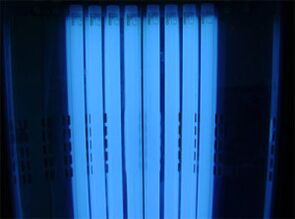Psoriasis has been known to mankind for a long time. For the first time it is mentioned in the Bible, but so far there is no complete understanding of the causes of these rashes. Scientists are trying to connect this disease with complex disorders of the immune and endocrine systems, and they also consider it hereditary. But absolute success was achieved only in one thing: there was a firm conviction that this disease is not a manifestation of infection of the body. That is, psoriasis is not contagious.
What is psoriasis?
Another name for this disease is scaly lichen. It mainly affects the scalp, the outer side of the elbows and knees, where dark pink scaly rashes appear. Of these, psoriatic plaques are soon formed. They have a pronounced white growth, consisting of dense scales, which causes cracking in the affected areas, accompanied by itching and the formation of exuding sores. Despite the fact that the causes of the eruptions are not clear, the mechanism of their appearance is well understood. With the appearance of psoriatic scales, the life cycle of epidermal cells in these and adjacent areas is drastically reduced to 4-5 days, in contrast to the normal 28-30 days.
Is psoriasis dangerous?
As its etiology is unclear but there is convincing evidence that the disease is systemic, affecting not only the skin but also the internal organs, it leads to the following disorders in the body:
- the appearance of psoriasis-like changes in the mucous membrane of the urethra and bladder
- causes subacute conjunctivitis, lens sclerosis, and other eye and eyelid diseases
- with an exacerbation of the disease, an increase in the liver with hepatocellular insufficiency and splenomegaly is observed
- enlarged lymph nodes
- there is muscle weakness, its atrophy with a tendency to progressive weight loss
It is possible to list the complications that psoriasis takes for a long time, but from this short list of them it is clear that the disease is serious and dangerous. The situation is compounded by the fact that, at present, therapeutic agents are only able to control and suppress the course of the disease, but not to cure it. Psoriasis is permanent but can be accompanied by long periods of remission.
What can cause the disease to flare up or cause it to relapse?
Despite the fact that the manifestations of psoriasis are not systematic, there are factors that can provoke the appearance of rashes on various areas of the skin. Therefore, patients should be aware of this and, if possible, beware of its influence. The following causes aggravate the course of the disease:
- overweight. It is noticed that among those who suffer from psoriasis, most of them have varying degrees of obesity.
- Stress. Many patients find that their psychological reaction to traumatic situations and circumstances exacerbates the manifestations of the disease.
- Some medications taken by the patient for various reasons can cause a relapse.
- Hypothermia.
- Psoriatic plaque damage and scratches. It was observed that, in the vast majority of cases, the mechanical irritation of the squamous lichen causes its growth and the appearance of new eruptions in the nearby areas.
- water procedures. In some people, after bathing or swimming in a pond, an exacerbation of the course of the disease is observed.
- Sun rays. Moderate exposure to sunlight in psoriasis is considered beneficial by doctors. But there are a number of patients who claim that such baths cause an exacerbation of the disease in them. Also, it didn't matter how long they were in the sun. Therefore, the question of whether it is possible to sunbathe with psoriasis still does not have a clear answer. To decide for yourself how useful or harmful are the sun's rays in this case, you need to take into account several factors at once: individual tolerance to the sun, skin color and type, stage of the disease and its form.
Ultraviolet for psoriasis: benefit or harm

- Light therapy as one of the treatments for psoriasis:
- PUVA therapy is photochemotherapy, whose mechanism of action is quite difficult to understand. Often used in the treatment of exudative and vulgar psoriasis. Very effective for rashes on the scalp, palms and feet. 3-4 sessions of ultraviolet irradiation are prescribed weekly, until the complete disappearance of the psoriatic plaques. On average, 15-25 procedures are required, including local exposure sessions.
- SFT therapy is selective phototherapy. Up to 5 procedures per week are prescribed for exudative and vulgar psoriasis. The radiation dose in the absence of erythema is increased each time. Complete course of treatment - 20 - 30 sessions. It has a pronounced therapeutic effect in 85-90% of cases.
- UVB therapy is phototherapy, which is comparable in its effectiveness to PUVA therapy. The course of treatment is 20-30 procedures.
Psoriasis and solarium: benefit or harm?
The main difference between tanning in a solarium and in the sun is that, under artificial conditions, melanin production takes place without exposure to dangerous ultraviolet radiation, in particular UV-C rays, which are harmful to the skin during tanning. Solariums do not use this type of radiation. However, at the initial stage of the manifestation of the disease, indoor tanning helps to stifle the development of rashes. Therefore, doctors do not recommend the treatment of psoriasis with solarium, but they do not find any contraindications to its use as a therapeutic agent.
The effect of radiation in a solarium on the skin
- UV-A rays have a beneficial effect on patients with psoriasis, seborrhea, acne, neurodermatitis.
- UV-B rays initiate the process of active production of vitamin D3, which reduces the effect of stress on the body and, as it became known, causes psoriatic rashes.
Thus, a visit to the solarium cannot have a negative impact on the course of the disease and can, to some extent, dampen it. But why then are there people to whom indoor tanning sessions bring only harm? The answer is that the combination and wattage of lamps in solariums are different. When choosing a salon, you should ask about its spectral composition, one of the most important characteristics. The lamps are designed with various combinations of UV-A and UV-B radiation. For example, those with UV-B 1% or less are classics and those with UV-B above 1% are professionals.

It is also important to have a reflector. If not present, radiation hits weakened skin, and if present, then concentrated. The reflector can be located either on the lamp itself or outside it. Whether or not there is a reflective layer on the lighting device, you can understand if you look at the lamp through the light. If there is, the efficiency of its radiation is 10% greater than that of a conventional one.
Therefore, for psoriasis treatment with a solarium to be beneficial and not harmful, it is necessary to choose the right tanning studio with the right combination of UV radiation. Too much is always harmful to the skin and leads to the formation of tumors and other problems with it. The ratio of UV-A and UV-B rays is very important for patients with psoriasis. The best option here would be the following combination: UV-B waves with a length of 311 nm. and UV-A waves 300-400 nm. This ultraviolet radiation ratio has a Daavlin photo booth, which emits nbUVB 311nm narrow spectrum light. Those who visit him notice a marked improvement in their condition. The course of therapy is 20 to 30 sessions.
Therefore, the question: does a solarium help with psoriasis can be confidently answered - yes. But it is important not to thoughtlessly choose a studio close to the place of residence, but to be interested in the spectral characteristics of the emitting lamps in it. It is important to know that a vertical tanning method is preferable to a horizontal one. Time spent in the cabin should not exceed 5-6 minutes, and sessions should be rotated every other day. UV rays in moderate doses help to strengthen the immune system. Which is extremely necessary for a patient with psoriasis.























